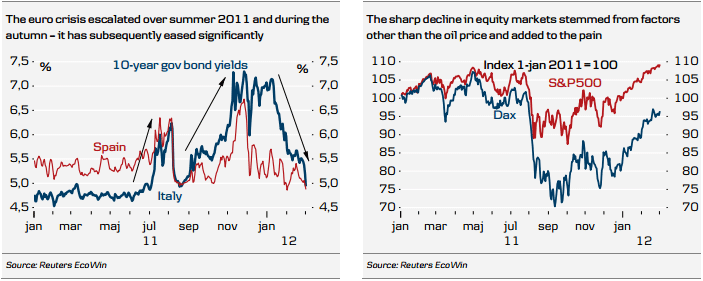- Oil prices are again on the rise creating a new risk to the global economy. Thistakes thoughts back to early 2011 when the global recovery was confronted with a sharp rise in oil prices followed by a downturn in the global economy.
- In this document we look at how much it would take to derail the reocovery. We outline three scenarios for the oil price and estimate how much they affect the global economy.
- So far, the rise in the oil price has been moderate and we expect the effects to be limited, although it will dent the US recovery somewhat in the short term.
- Our estimates suggest the oil price has to go above USD140/bl to have a material impact. This would create a soft patch in the US, with growth below 2% and prolong the period of weak growth in the euro area. We expect China to be least affected.
- Should oil prices rise to USD170/bl, we project the US would experience a sharp slowdown, with growth below 1% for the rest of the year. The recession in the euro area would also be prolonged. Chinese growth would also be hit but would remain at decent levels.
- Oil price shocks tend to hit the US the most relative to Europe and Asia. 2011 déjà vu?
Over the past month, we have seen a sharp rise in oil prices from around USD110/bl in H2 11 to above USD125/bl Brent oil – a rise of USD15/bl. This bears some resemblance to early 2011 when the oil price shot higher on a ombination of stronger global growth and geopolitical risks.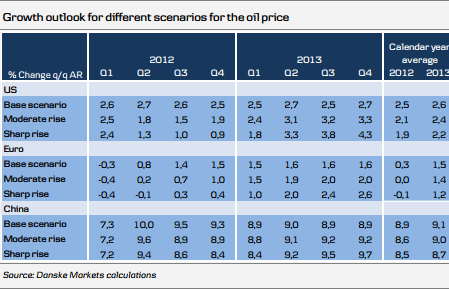
In 2011 the geopolitical risk stemmed from the unrest related to the Arab spring, today it is instead coming from the tensions related to Iran’s nuclear development.
Importantly, the oil price rise is so far not reason for real concern. Oil prices have risen USD15/bl over the past month, compared with a rise in late 2010 to April 2011 from USD75/bl to just below USD130/bl, a rise of more than USD50/bl. The rise in the oil price rise in 2007/08 was also far stronger at USD80/bl over a period of 1.5 years.
However, there is a clear risk that the oil price could continue higher, as there are no signs that the tension with Iran is likely to ease and we fear things will get worse before they get better. Our expectation of continued recovery signals in Asia and Europe in terms of higher PMIs and growth could add to the upward pressure on the oil price. Hence, it is relevant to look at how vulnerable the global economy is to a further rise in the oil price.
When will the oil price become a problem? Scenario analysis
In order to address this question, we look at two different scenarios for higher oil prices and the effects on growth.
Our current growth forecasts are based on our baseline scenario that oil prices moderate soon and average around USD120/bl for the rest of 2012. Our first alternative scenario entails a moderate rise in the oil price towards USD145/bl by September, followed by a decline again in 2013. This could be triggered by a combination of increasing tension with Iran and a stronger growth outcome in emerging markets. The second scenario is one of a sharper rise towards USD170/bl by the end of the year. A trigger for this scenario could be an armed conflict with Iran giving serious supply concerns in the market.
The scenarios for growth in the different outcomes for oil prices are shown on the table on the front page and in the charts below. We have used oil multipliers based on estimates from international organisations and our own calculations (see box overleaf).
Scenario 1 – moderate rise in the oil price towards USD145/bl: In this scenario, the US enters a soft patch in coming quarters as growth dips below 2% in Q2, falling to 1.5% in Q3 and stays below 2% in Q4 (all growth rates are q/q annualised). In 2013, growth recovers again as we assume the oil price declines and thus becomes a tailwind again.
In the euro area, GDP growth remains very subdued at 0.2% in Q2 and remains below 1% throughout 2012, before recovering in 2013.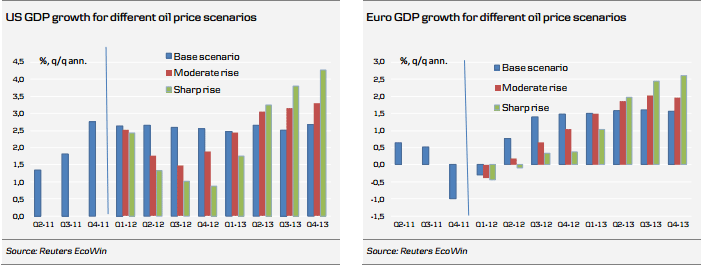
China is less affected but would also be negatively affected. However, we still expect the economy to grow around 9% throughout the year and rise slightly in 2013.
Estimating the impact on growth of higher oil prices
The issue is quite complicated as oil prices hit growth through many channels. The most direct channel is the effect on consumers as it pushes up inflation and erodes real income growth. However, there are also effects from a higher cost for transport and higher input costs in production. Standard multipliers suggest that a rise in the oil price of USD10/bl would shave close to 0.5% from GDP after one year in the US and 0.3% in the euro area. However, there is quite a big spread between estimates from different models highlighting the uncertainty over the impact.
In judging the economic impact, what is driving the rise in the oil price is also relevant. If it is only a supply shock, the negative effects are likely to be bigger than otherwise. On the other hand, if it is driven by stronger demand, a rise in the oil price would go hand in hand with higher growth. Hence, it is growth driving the oil price, not the other way around. Simple multiplier calculations assume it is an exogenous shock and as such a pure supply shock. Currently, one can argue, though, that the rise in oil prices is driven partly by the stronger economy globally and hence to some extent is demand driven. This means that calculations based on standard multipliers are likely to overestimate the effect a bit. For this reason we have based our scenario calculations on slightly lower multipliers: -0.3 for the US, -0.2 for the euro area and -0.15 for China. We have also assumed that most of the effect comes in the first quarters and tapers off thereafter, although for China the lag is a bit longer as it mostly affects growth through the indirect channel via the effect on input costs and thus earnings and investments. The effect also depends on the policy response. By using standard multipliers, we have also assumed a “standard response”.
We have assumed a temporary rise in the oil price for two reasons. (1) This is the normal pattern when the rise is triggered by geopolitical tensions. The price goes up until tensions are resolved and then fall back. (2) A sharp rise in the oil price is selfdestructive in the sense that growth weakens and oil demand falls sharply. This putss downward pressure on prices with a lag.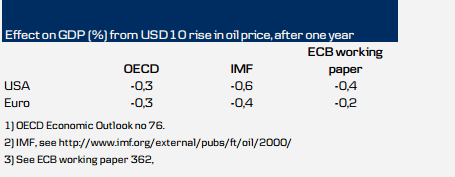
Scenario 2 - sharp rise in the oil price towards USD 170/bl: In this scenario, the US hits a real slowdown in the coming quarters, with growth falling to around 1% in the coming three quarters. This is clearly below trend and unemployment would start rising again. As the oil price tapers off in 2013, growth would recover again. As the assumed decline in the oil price is quite sharp, the rebound in growth would also be strong. This has also been seen after previous oil price rises following the military conflicts with Iraq.
In this scenario, the euro area recession would drag out and growth would resume only to very weak levels.
Chinese growth would also take a harder hit but the economy would still be expected to grow above 8% throughout the period.
US most exposed to oil prices – EM and Europe less so
In general, the US is the most exposed economy to oil price rises and hence the effects are biggest there. The most direct effect from the oil price is the hit to consumers and as the US economy is a very consumer driven economy with consumption being 70% of GDP, the effect is bigger there.
China is not as exposed to the oil price, as the energy component is less than 7% of the consumer basket and consumption is a much smaller part of the economy (only around one-third). Also there is little spillover to other energy prices, such as electricity, as these prices are heavily regulated. Food prices are much more important for China as they constitute more than 30% of the consumer basket. So far, there has been little spill over from the oil price to food prices. Indeed, food prices have been falling. This is giving the People’s Bank of China leeway to stimulate the economy if it slows down while inflation is going lower.
In the euro area the economy is less consumer driven than the US and more export driven and exports are increasingly driven by emerging markets, as these markets are now much bigger than the US and are growing much faster. With emerging markets growth still robust, this should provide a buffer for Europe. This also explains why for example German growth was quite robust throughout 2007 and the early part of 2008 despite the very sharp rise in oil prices over that period.
Central bank response would differ
In the “moderate rise“ scenario, the Fed is likely to refrain from QE3 as weaker growth is counterweighed by higher inflation. The ECB would also probably remain on hold in this scenario, as the weaker economy would keep it from hiking despite higher inflation,particularly because the rise in inflation would be seen as temporary. In China,policymakers may ease more than in the baseline scenario, as inflation is affected so much while growth is weaker.
In the “sharp rise” scenario, we would expect the Fed to implement QE3. Even though inflation would go up, the sharp slowing of the economy and rising unemployment would be taken very seriously and this would dominate the inflation concern, which would be seen as temporary. This was also the case in 2008 when the Fed eased while oil prices rose sharply. The ECB is also likely to remain on hold in this scenario. Inflation would rise towards 3% and stay there throughout 2012. However, as this is temporary and the economy would be in recession – or growing only marginally – we would expect the ECB to refrain from hiking. In China, we believe the central bank would ease more to accommodate growth as the impact on inflation is not significant. However, it would depend on the spillover to other commodities – not least food. If food prices started going up, the room for manoeuvre would be smaller.
Important differences from 2011
As many are comparing now with 2011 fearing a repeat of the slowdown following a sharp oil price rise, it is worth highlighting some of the differences from 2011. In 2011there were a range of other factors contributing to the downturn on top of the rise in the oil price. The total headwind facing the global economy was thus very significant, which explains the slowdown. These headwinds are not in place this time. On the contrary, many of them have become tailwinds.
1. Food prices rose significantly in tandem with the rise in the oil price. This time food prices are actually falling. Food prices are very important for emerging markets growth as food has a very high weight in the consumer basket in these countries (above 30% in China and close to 60% in India). Higher food prices cool growth mainly through two channels: (1) pushing up inflation and eroding purchasing power for consumers, and (2) triggering policy tightening in response to higher inflation. The food price shock came on the back of adverse weather patterns stemming from the weather phenomenon La Ninã. This year global food prices have fallen and this has already pushed down inflation in emerging markets and is likely to continue to do so in coming months. Hence, inflation would fall, boosting purchasing power and policy would be eased in response – leading to a tailwind for growth. As emerging markets drive 75% of global growth, this is quite important.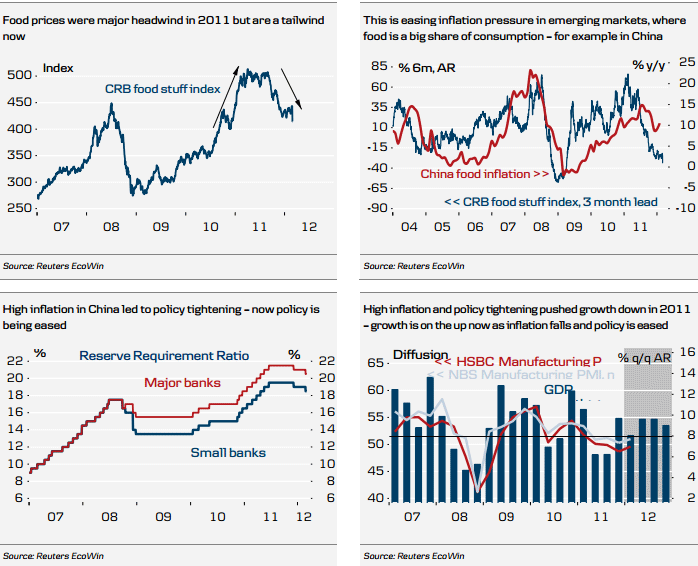
2.The Japanese earthquake added to pain at a critical time. It took place in March and had the main negative effects in the following two to three months. This caused supply disruptions and the global auto industry, in particular, was hit temporarily. This hit came just when the effect of the higher oil price and higher food prices were starting to bite.
3. The euro crisis escalated during spring 2011, with Italy being sucked into the crisis as Italian bond yields started to go up. This caused great uncertainty over a potential breakdown of the euro. Today, the euro crisis has eased substantially, as the ECB’s three-year LTRO has led to a sharp increase in demand for bonds in, for example,Spain and Italy. Hence, this headwind has eased significantly.
4. The US downgrade that took place in early August added an extra negative event to the already vulnerable markets and it seemed to be the straw that broke the camel’s back and led to a subsequent sharp decline in equity markets and stress in credit markets. This is no longer in focus.